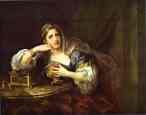Giovanni Boccaccio
Boccaccio, Giovanni
(1313-75), Italian
writer and humanist, born into a family of a Florentine merchant. His youth
he spent in Naples, where be began his literary studies and wrote his first
works. In 1340 he returned to Florence. Municipality of Florence employed
him for different diplomatic missions. His main literary work is Decameron.
See: Andrea del Castagno. Giovanni
Boccaccio.
 The
Story of Nastagio degli Onesti is a novella from
Decameron,
it
tells the story of the young Nastagio from Ravenna, who cunningly uses
a horrific event in order to persuade his beloved to marry him.
The
Story of Nastagio degli Onesti is a novella from
Decameron,
it
tells the story of the young Nastagio from Ravenna, who cunningly uses
a horrific event in order to persuade his beloved to marry him.
See: The Story of
Nastagio degli Onesti in 4 frescos by Botticelli:
1. The Encounter with the Damned in the Pine Forest. Nastagio,
rejected by the lady he admires, retires in the pine forest. There he suddenly
comes upon a knight on horseback who is hunting a naked woman with his
hounds. Nastagio seizes a branch in order to protect the defenseless woman.
2. The Infernal Hunt. Nastagio watches with dismay as the knight
tears out the woman's heart and entrails and feeds them to his dogs. Then
the armed rider is once again hounding his victim along the shores of the
ocean. The chase is hell's punishment for the hunter, whose despairing
love caused him to commit suicide, and for the naked woman, who was cruel
to her lover; it is a punishment that will be repeated eternally.
3. The Banquet in the Pine Forest. Nastagio made up a cunning
plan. He has invited guests to the pine forest in order to show them the
horrible chase. The woman he desires, wearing the white dress, has always
rejected his advances but now watches the events in dismay. As she is afraid
of suffering a similar fate, she sends a servant to Nastagio, as we can
see in a second scene on the right, and agrees to become his wife.
4. The Wedding Banquet. Nastagio's wedding is celebrated on
a splendid scale under a monumental loggia. The coats of arms suggest that
the cycle of painting was commissioned on the occasion of a wedding in
Florence between the Pucci and Binni families.
 Sigismonda
from Decameron is the daughter of Tancred, Prince of Salerno.
Her father, having discovered her love to his squire Guiscardo, slew the
latter and sent his head in a golden cup to Sigismonda. She took poison
and died. The father, repenting his cruelty, ordered the pair to be buried
in the same tomb.
Sigismonda
from Decameron is the daughter of Tancred, Prince of Salerno.
Her father, having discovered her love to his squire Guiscardo, slew the
latter and sent his head in a golden cup to Sigismonda. She took poison
and died. The father, repenting his cruelty, ordered the pair to be buried
in the same tomb.
See: William Hogarth Sigismonda.
Cymon and Iphigenia is from Decameron.
Cymon,
the son of a nobleman of Cyprus, a handsome, though coarse and unlettered,
youth, fell in love with the girl Iphigenia. The love made him a miracle;
he was turned into an accomplished and polished courtier.
See: Sir John Everett Millais Cymon
and Iphigenia.
Sir Joshua Reynolds. Cimon
and Iphigenia.